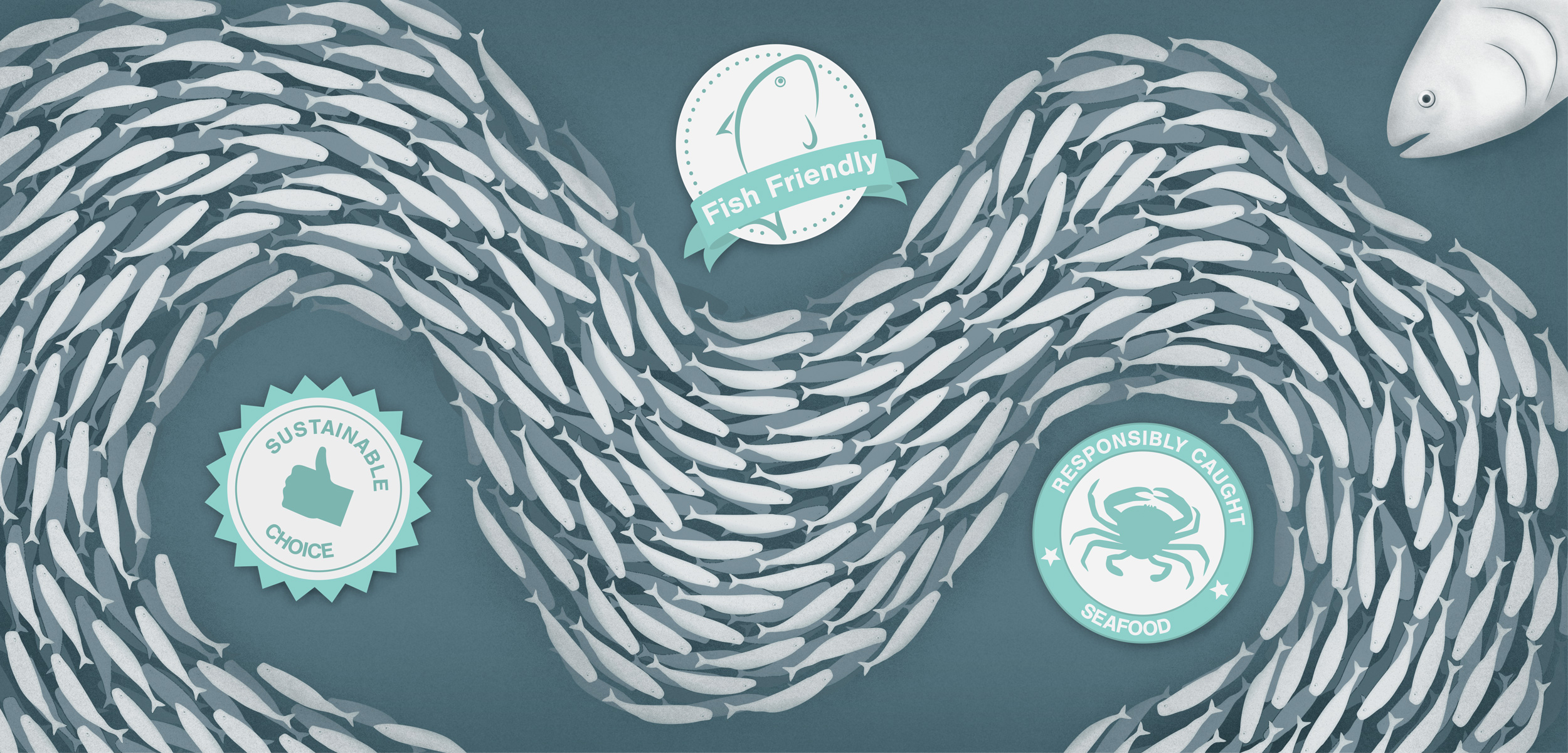The Ecolabel Fable
Buyer beware: sustainable seafood programs can’t guarantee ocean-friendly choices.
Article body copy
When did lunch become so complicated?
The server at the sushi restaurant hands me the menu, and I’m hit with a wave of anxiety as I count four pages, printed front and back. I was hoping the menu would be as minimalist as the modern decor. I have only 45 minutes, and I’d like to enjoy a conversation with my husband, something we don’t get to do over meals at home with the kids. But as I scan the specials, I spot a familiar fish face. It’s the Vancouver Aquarium’s Ocean Wise logo, a sign of a sustainable seafood choice. Decision-making made easy! But it seems almost too easy.
“Are these all Ocean Wise?” I ask our server, pointing to the 11 nigiri items with the stamp next to them. She assures me they are, and I ask for more time to peruse the menu. When she turns away, I pull out my phone and select the Ocean Wise app, which allows users to find restaurants across Canada that are part of the program and check on the sustainability status of seafood. I search the partner directory for the Next Modern Japanese Cuisine in Victoria, British Columbia, but it doesn’t appear, suggesting the restaurant is not an Ocean Wise member. Before I have a chance to check some of the seafood, the server returns.
What was supposed to be a stress-free lunch becomes an interrogation. Are the scallops Japanese? Yes. Farmed or wild? Wild. How were they caught? “I checked with Ocean Wise,” she says. “It’s Ocean Wise accordant.”
We place our order, and I cross-check our server’s answers with the seafood guide on the app. Japanese scallops can be Ocean Wise, but only if they’re farmed. I ordered the rock crab maki with tobiko, or flying fish roe, but when I look it up, I see that tobiko is under review. The roll is therefore not Ocean Wise as the menu suggests.
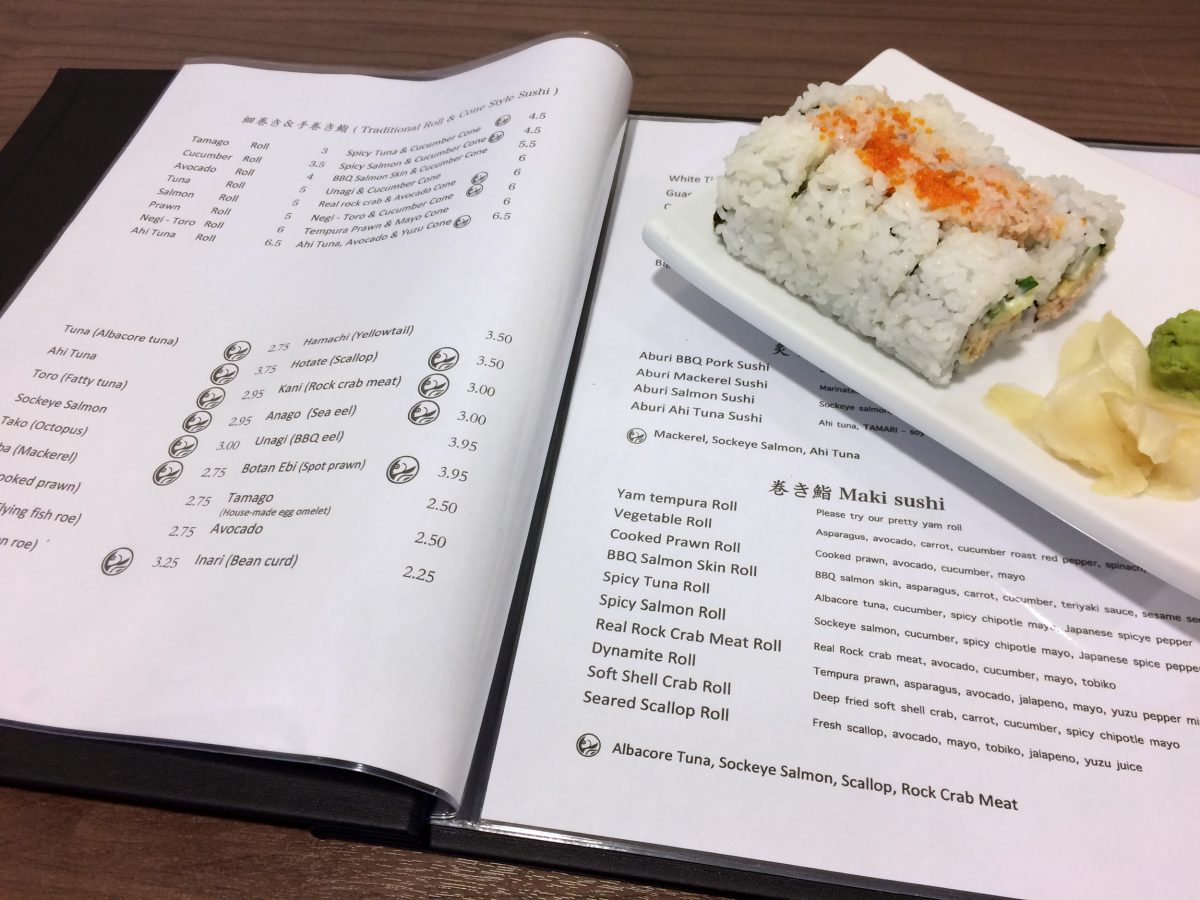
The menu at the Next Modern Japanese Cuisine in Victoria, British Columbia, features the Ocean Wise logo exactly 18 times, but the legend explaining the sustainable seafood program is noticeably absent. The logo is also being used incorrectly: it should be next to individual menu items, not indicating the ingredients that are Ocean Wise in a list of dishes. Photo by Raina Delisle
I’ve long been a fan of the Ocean Wise program, preferring to have my seafood without a side of guilt. Like more than 90 percent of Canadians, I think it’s important that seafood comes from sustainably managed stocks, so I buy less fish so I can afford to pay a premium for seafood that guarantees I’m not complicit in the destruction of species and ecosystems—and you will pay more for some sustainable seafood. But when a study revealed that restaurants are passing themselves off as Ocean Wise members when they’re not, it became clear to me that eating sustainably is not as simple as looking for a logo.
The author of the study, Katherine Dolmage, was exploring what motivates restaurateurs to become Ocean Wise members. She interviewed 70 chefs or owners in Vancouver, British Columbia, 36 of whose restaurants weren’t Ocean Wise members. But of those nonmember establishments, several were falsely claiming to be Ocean Wise. (Dolmage can’t recall the exact number as it was not the focus of her research.) In the paper, Dolmage and her coauthors wrote: “Although this suggests that restaurateurs see value in the logo, it also could undermine the credibility of the program.”
After completing her research, Dolmage, who has since taken a job with aquaculture giant Marine Harvest, continued to find more restaurants misusing the logo. She just happened upon them when she was out for a meal, as I did when I went for sushi at the Next Modern Japanese Cuisine. And when I headed to my local pub, Fifth Street Wood Fired Rotisserie, for pizza Monday. And when I met some eco-minded friends at farm-to-table empire 10 Acres, which has three restaurants. I wonder how many more Ocean Wise scammers are out there, how they’re getting away with it, and what it means for the future of sustainable seafood.
Branding Sustainability
The Vancouver Aquarium is nestled in Stanley Park, protected by a fortress of lush green trees and so close to the ocean that the breeze brings with it the smell of the beach. It’s been a challenging few weeks for staff and supporters as they await the vote that could end the aquarium’s captive cetacean program—the big draw for many visitors—but general manager and vice president Dolf DeJong is cheery despite the deadline. (The Vancouver Park Board will later vote in favor of a bylaw banning whales, dolphins, and porpoises in captivity.)
“We have a pretty unique recipe here,” DeJong says as he leads me on a walking meeting, sporting a red aquarium vest over his dress shirt. “We’re a not-for-profit that has a sustainable seafood program, but we also have this incredible engine in Stanley Park that sees one-plus million people a year. When they’re hearing about African penguins and are amazed by these little black and white animals, they get a message on sustainable seafood. We’re trying to develop a conservation-minded identity.”
At the café, I see what DeJong calls “guerrilla engagement” in action. On the wall next to the water station (the aquarium recently stopped selling plastic bottles), a poster encourages people to download the Ocean Wise app. The dining area features a large mural showing fish, shellfish, and cutlery, along with the odd Ocean Wise logo appearing like a subliminal message. A panel promotes the program: “The Ocean Wise symbol next to a seafood item is the Vancouver Aquariums’s [sic] assurance of an ocean-friendly seafood choice.”

The café at the Vancouver Aquarium is a billboard for the Ocean Wise program. Can you spot the logo among the fish and forks? Photo by Raina Delisle
The aquarium launched Ocean Wise in 2005 to help consumers make environmentally responsible choices for the ocean. It has since become “the Kleenex of the sustainable seafood world,” DeJong quips, with more than 700 restaurant, retail, and supplier partners, many of which are chains with multiple locations across the country.
When a business is interested in becoming a member, the first step is having the seafood it sells assessed. Having just one Ocean Wise item qualifies a prospective partner for the program, even if it’s sold alongside several other unsustainable items. After paying the annual membership fee—starting at CAN $275 for restaurants and going all the way up to $5,200 for suppliers—a business can use the logo next to menu items or on packaging.
There are guidelines on how the logo can be used and a branding approval process, but there are no restrictions on the language that can be used to promote the partnership. As a result, a restaurant can boast on its menu or website that it’s a “dedicated Ocean Wise partner,” for example, and potentially lead consumers to believe that all its seafood is ocean friendly. (About 20 percent of partners sell only Ocean Wise seafood.)
The Ocean Wise program is a powerful marketing tool for its partners and the aquarium. DeJong makes sure of that with what he calls the “double century”—putting on 100 Ocean Wise events that engage at least 100 partners every year. The organization has declared November Ocean Wise month and is advocating for a national sustainable seafood day.
Citing data from an Insights West poll conducted last year, DeJong proudly points out that a third of Canadians have heard of Ocean Wise. That same poll found that 18 percent of Canadians have purchased Ocean Wise seafood, a number that is likely to climb as the program puts more emphasis on Atlantic Canada and Asian restaurants and retailers. The organization is also considering expanding into the certification of other consumer goods, such as clothing and beauty products.
To punctuate its commitment to conservation, Ocean Wise recently rebranded and became the name of an overarching conservation organization based at the aquarium. The announcement was made on World Oceans Day, just a few weeks after the park board vote on captive cetaceans. A stylized fish and the words “a sustainable choice” replaced the familiar fish head logo. The aquarium, its research and education arms, the sustainable seafood program, and other conservation initiatives now fall under the Ocean Wise umbrella—a testament to the visibility and power of the brand. But with great growth comes great responsibility.
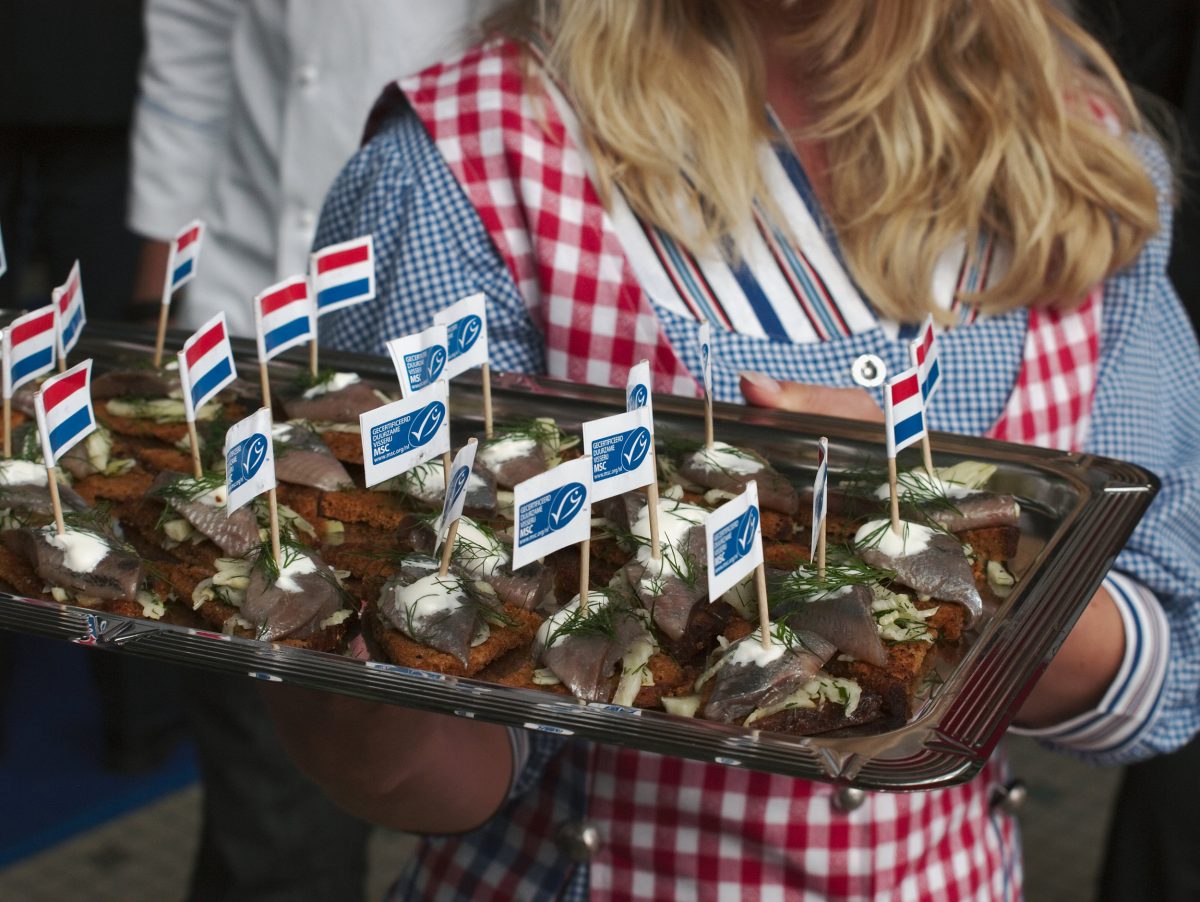
The Marine Stewardship Council’s blue fish logo can be found worldwide, including on this French party platter. Twelve percent of wild marine fish caught worldwide is certified by the organization. Photo by MSC/Nathalie Steins
As we walk alongside the Vancouver Aquarium’s outdoor pools, two sea lions poke their heads out of the water, and I ask DeJong how Ocean Wise protects its brand and ensures restaurants are not misusing the logo and misleading customers. “There are tens of thousands of restaurants in Canada, and I won’t say we’ve walked in the door of every one of them to check how they’re using or not using the Ocean Wise logo,” he says. “But we have great support from the community, and if we do have people who are using it improperly, we hear about it. We are a group of food-loving restaurant aficionados. Whenever our team here at the aquarium are out, they’re actively looking.” DeJong acknowledges that logo misuse is a problem and divulges that they caught a restaurant using the Ocean Wise logo on a dish that didn’t even contain seafood.
But having a staff of foodies and relying on secondhand reports is a shaky enforcement strategy. Ocean Wise takes no proactive measures to ensure nonmember restaurants or retailers aren’t misusing the logo, so the aquarium’s guarantee that the symbol indicates an ocean-friendly choice rings hollow. In fact, a quick Google image search for the old logo places it on the websites of several nonmembers, including a street-food chain in Italy that specializes in calamari wraps.
When a report filters in that a restaurant is misappropriating the Ocean Wise logo, the organization contacts the owners and tries to recruit them as members. According to Ocean Wise, between 80 and 90 percent of restaurants that are busted join the program. Yet they have no data on how many members they’ve recruited in this manner, nor how many reports of misuse have piled up over the years. The information is buried in emails, phone logs, and notes, explains Ocean Wise communications manager Alexis Brown, and they don’t have the capacity to comb through their files. “It’s not a number that we would use to measure if we’re meeting the program’s goals,” she writes in an email.
Not only is misuse of the Ocean Wise logo greenwashing, it’s also against the law. Environmental claims are subject to Canada’s Competition Act, which contains criminal and civil provisions that prohibit making false or misleading claims to promote a product. If you spot someone misusing an ecolabel, you can file a complaint with the Competition Bureau. The Competition Tribunal or the court may order the business to publish a corrective notice or pay a penalty. The bureau does not, however, regulate organizations that award ecolabels.
Ocean Wise has no legal obligation to monitor its program, but it does have a moral one.
Our walking meeting ends in DeJong’s office, and we sit at a round table with a bowl of giant Corn Nuts in the middle. I tell him about some of the Ocean Wise cheats I’ve discovered, and hand him a photo of the Next Modern Japanese Cuisine’s menu and a printout of Fifth Street Wood Fired Rotisserie’s home page, which prominently reads, “Fifth St. fully supports the Vancouver Aquarium Ocean Wise program.” DeJong studies the documents and shakes his head. “I look forward to visiting them,” he says.
Fifty Shades of Blue
The seafood section at Whole Foods Market is reminiscent of the last day of school when every kid gets a certificate of some kind—most caring, biggest helper, good citizen—rendering the accolades somewhat meaningless. According to the product cards propped up in front of the rows of pink seafood at the counter, the crab cakes boast “full traceability from fishery or farm to store,” the shrimp are “Responsibly Farmed, 3rd Party Verified,” and the cooked shrimp meat is certified sustainable by the Marine Stewardship Council (MSC).
In the frozen fish section, nearly every product carries some kind of stamp of approval: Ocean Wise, Aqua Star’s Seafood Forever, Non-GMO, and Whole Foods Market’s very own Responsibly Farmed. All of the labels have different definitions of sustainability, and few address social issues such as child labor and working conditions. Conscientious consumers would be well advised to choose the issues that are most important to them and look for the label that best addresses them—it’s like shopping for anything. But unless you’re an industry insider, it’s hard to know which programs are reputable and who to trust. Yet 65 percent of Canadians look to retailers and producers for information about the origin and sustainability of seafood.
There are hundreds of ecolabels worldwide, including more than a dozen exclusively for seafood products. Lucy Atkinson, assistant professor in the Stan Richards School of Advertising & Public Relations at the University of Texas at Austin, has studied how ecolabels influence consumers. In the past few decades, she says, the number of them has grown exponentially. “It’s so chaotic,” she says. “There are so many different kinds of labels, so many different kinds of standardizations, regulations, and enforcements that it really is the Wild West of ecolabels.”
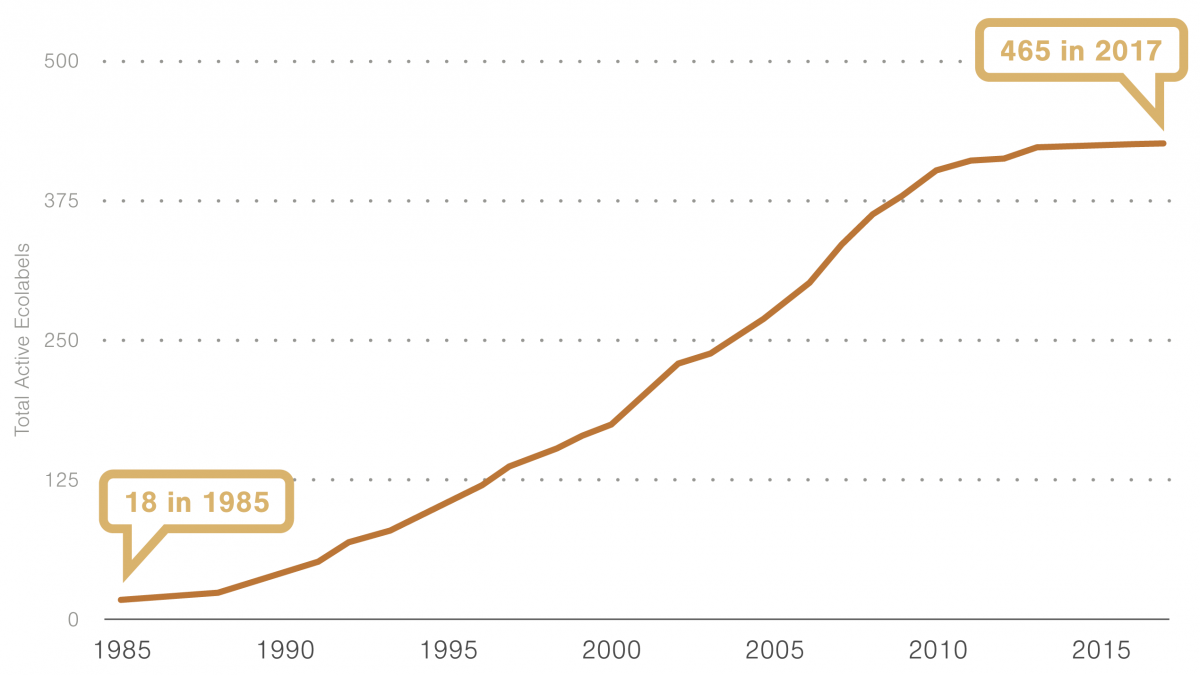
Governments, industry bodies, companies, and nonprofits issue ecolabels, which are meant to make purchasing decisions easier for eco-conscious consumers. The Vancouver-based Ecolabel Index lists 465 labels in nearly 200 countries, representing 25 industries. Data from Ecolabel Index, illustration by Mark Garrison
Atkinson says her research suggests that consumers value ecolabels—they assure us of qualities, such as organic and GMO free, that we can’t easily verify ourselves, and give us a warm fuzzy feeling of doing the right thing for the environment. Companies like ecolabels, too, and have been capitalizing on consumer demand for sustainable products and services by stamping them on everything from tampons to hotels. The global retail value of eco-certified seafood alone was estimated at US $11.5-billion in 2015—that’s about the same sum Burger King forked over to buy Tim Hortons.
But a study published in the journal Fisheries Research shows that market forces can lead ecolabeling schemes to make questionable claims, potentially driving down standards. And people are catching on. “Consumers don’t want the equivalent of a green check mark,” Atkinson says. “We see terrible ecolabels out there that have absolutely no meaning or substance to them, and then we see more valid and trustworthy ones. Figuring out which one is which is hard for the consumer.”
The two big players in sustainable seafood ecolabeling in North America are the MSC and the Monterey Bay Aquarium’s Seafood Watch program, and they operate quite differently. The MSC is an opt-in program, and fisheries seeking certification pay to go through the process. The international organization has strict standards that ensure the seafood it certifies is traceable from catch to plate. Meanwhile, Seafood Watch assesses fisheries it believes consumers should know about, including the worst environmental offenders, and issues recommendations, but does not tackle traceability.
Ocean Wise is the only existing made-in-Canada sustainable seafood ecolabel. It uses Seafood Watch’s assessments as the basis of its program and also does its own assessments of small-scale Canadian fisheries. Until recently, it had a Canadian competitor in the retail market: SeaChoice, which also used Seafood Watch’s science.
For a decade, SeaChoice worked with retailers to establish sustainable seafood purchasing policies and verify the authenticity of every species that landed in its partners’ coolers. In 2015, SeaChoice dumped Overwaitea Food Group because it couldn’t verify where its seafood was caught. Less than a year later, the Western Canada chain became an Ocean Wise partner. As of last December, all of SeaChoice’s other retail partners—including Safeway, Federated Co-operatives Limited, and Buy-Low Foods—had either met or nearly met their sustainable seafood objectives. The organization has since transitioned to a seafood watchdog to hold the supply chain and ecolabels more accountable. As a result, many of the retailers have teamed up with Ocean Wise.
Seafood fraud is a high-stakes global challenge, and the supply chain is like the Trump family’s relationship with Russia—long, complex, and lacking transparency. A 2016 report by international conservation organization Oceana found that 20 percent of more than 25,000 samples of seafood tested worldwide was mislabeled. According to the report, up to 41 percent of seafood samples tested in Canada were mislabeled. The MSC does biannual DNA tests on seafood that carries its label and consistently finds that less than one percent is mislabeled.
The MSC also requires restaurant partners to obtain chain of custody certification through an independent certifier who conducts annual audits. The restaurant must operate a traceability system and ensure there are no substitutions or mixing of certified and non-certified products. There are 23 MSC restaurant partners in Canada, including several universities, which can be verified through the organization’s online directory. Ocean Wise has no traceability requirements, so there’s no guarantee that the “sustainable” halibut you order isn’t South African hake, a species that’s not recommended. So, should consumers try to catch the MSC fish and throw the Ocean Wise one off the line? Not so fast.
Last month, SeaChoice released a searing report, “What’s Behind the Label,” that tarnishes the MSC’s reputation as the gold standard in ecolabeling and exposes serious flaws in how the world’s leading certifier of farmed fish, the Aquaculture Stewardship Council (ASC), operates. SeaChoice found that fisheries and farms certified by these labels are frequently not meeting all of the requirements, but flaunt the ecolabel anyway.
SeaChoice found significant timeline extensions and flexible interpretations of the MSC standards. To achieve MSC certification, fisheries are assessed on 28 sustainability indicators. If a fishery scores below a certain level on any indicator, it must improve its performance within a specified time frame, usually five years, to retain certification.
The SeaChoice report found that all certified fisheries in Canada received conditions after their original assessments—an average of six—and some have taken nine years after certification to meet all of the MSC requirements, suggesting they were granted certification prematurely. All the while, seafood was entering the marketplace with the MSC’s seal of approval, and consumers were none the wiser.
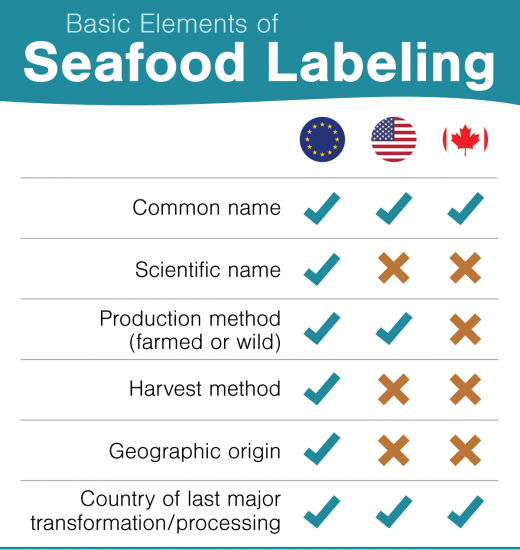
Seafood labeling regulations in Canada lag far behind those in the European Union, according to a recent report by SeaChoice. Without information on where or how a species was caught, consumers have no way of independently verifying its sustainability status. Data from SeaChoice, illustration by Mark Garrison
“They get an interim get-out-of-jail-free card, and what we’ve found is that it hasn’t really incentivized change,” says Scott Wallace, a senior research scientist at the David Suzuki Foundation, one of the organizations behind SeaChoice. “The five years go by and the same problems still exist, and they still get certified. And these are the key environmental issues around the fishery.”
In a sharply worded statement, the MSC says SeaChoice misinterpreted its data; SeaChoice responded, defending its analysis.
Meanwhile, the BC Salmon Farmers Association has a lofty goal to have all salmon farms in the province certified by the ASC by 2020, but the SeaChoice report found that the ASC’s claim that farms have to be 100 percent compliant to be certified is false. SeaChoice found that nearly every farm had to apply for a variance to the standard to earn certification. Most departures from the standard are related to the issues that matter the most to consumers, such as parasite transfer to wild salmon. “This fish is in the marketplace now labeled as ASC salmon, but it’s not meeting the intent of the standard,” Wallace says. “It’s misleading the consumer about what’s behind these labels.” (The ASC has pledged to do better.)
In Canada, consumers are more reliant on ecolabels for information about their seafood than they are in the United States or the European Union because regulations on mandatory product labels here are so weak. In Canada, labels are not required to include a species’ scientific name, where it was caught, how it was harvested, nor whether it was farmed or wild. This limits the consumer’s ability to use tools such as the Ocean Wise app or Seafood Watch’s consumer guides to verify the sustainability status of seafood. SeaChoice and Oceana are both pushing for better labeling and traceability requirements.

A recent SeaChoice report questions the adequacy of the Aquaculture Stewardship Council’s rules around suspending and revoking fish farm certifications. Between February and July 2015, Marine Harvest’s Marsh Bay salmon farm caused seven sea lion deaths, five above the council’s threshold and a number that would have disqualified it from initial certification. Photo by Matthew Maran/Minden Pictures
“I think it’s high time that Canada follows what the EU is doing, and what the US is moving toward, and establish traceability rules for all fisheries,” says Josh Laughren, executive director of Oceana Canada. “Traceability is a big issue and one we think is better solved by government requirements on all seafood as opposed to foisting responsibility on voluntary labeling schemes. You ought not to have to buy a premium label in order to be sure that what you’re buying is what you think you’re buying.”
So with better government labeling, could we do away with ecolabels? Laughren doesn’t think so, pointing out that ecolabels address a range of issues—high by-catch levels, poor quota setting, habitat damage—unrelated to traceability. “I think we all hope for a day when the management of fisheries is at such a high bar that we don’t need ecolabels anymore,” he says. “In the interim, I still see ecolabels as a positive tool in blazing the path, pushing us forward, and raising the standard for all fisheries.”
The Post-Ecolabel Era
Red Fish Blue Fish is a sustainable seafood allegory. The popular eatery is perched on a dock in Victoria’s Inner Harbour and sells 100 percent Ocean Wise seafood from a recycled shipping container with a green roof that belies its past as home to a hulking, gas-guzzling Hummer. Locals and tourists alike brave the long summer lineup to enjoy fast seafood surrounded by an authentic coastal soundtrack—screeching gulls, baritone ship horns, and the drone of floatplanes.
Owners Libby Gibson and Simon Sobolewski have been dedicated Ocean Wise members since they opened the eatery in 2007. Today, they are putting up new menus with the redesigned Ocean Wise logo. “Sustainability and the environment have always been at the forefront of our minds right from the beginning,” Gibson says as we sit on stools overlooking the harbor.
Red Fish Blue Fish would serve sustainable seafood with or without Ocean Wise. Gibson and Sobolewski even go a step further, refusing to buy locally caught Ocean Wise halibut that travels to China to be processed and sent back. (Ocean Wise does not take greenhouse gases into consideration when certifying seafood.) “That’s a big waste in my mind,” says Gibson, adding that locally processed halibut costs significantly more.
A third of all Canadians are aware of Ocean Wise and three-quarters believe we’re doing too little to conserve our oceans. Hakai Magazine staff went down to Red Fish Blue Fish, an eatery in Victoria that only serves seafood approved by Ocean Wise, to find out what people think of the program. Video by Raina Delisle, Meigan Henry, and Jude Isabella
Gibson is surprised to hear that nonmember restaurants are passing themselves off as Ocean Wise, especially the Next Modern Japanese Cuisine, where she likes to go for sushi. “It bothers me,” she says. “If it starts to happen a lot and the public hears more about restaurants faking it then it might affect the businesses that are actually legitimate.”
Still, Gibson feels the brand recognition and validation they get from using the Ocean Wise logo is valuable. But aside from some retweets when they use the hashtag #OceanWise and mass emails informing them of changes to seafood assessments, they don’t get much else out of the partnership. DeJong says Ocean Wise representatives meet with partners or have phone check-ins at least once a year, but Gibson has never been contacted, raising questions about how the organization monitors legitimate members, too.
Three days after my visit to the Vancouver Aquarium, communications manager Alexis Brown sent me an email letting me know that the Next Modern Japanese Cuisine decided to remove the logo from its menu and Fifth Street Wood Fired Rotisserie joined the program. 10 Acres also became an Ocean Wise member, but the restaurant still displays the MSC logo on its website even though it’s not permitted to do so and is using it incorrectly. After mentioning this to the owner, I reported the misuse to the MSC through its online form, adding to its tally of 35 reports received globally in the past 12 months. The ASC also has a web page inviting people to report fraud, but Ocean Wise has no such system in place.
Brown says most cases of logo misuse result from misunderstandings, as was the case with Fifth Street. In her email, she explained that one of the restaurant’s suppliers is a partner, and they thought this allowed them to use the logo. A manager at the restaurant said the logo has been in use since she started two years ago, and she didn’t realize it was a membership-based program. Another Ocean Wise representative and the manager both said all of the dishes that were labeled as Ocean Wise actually were, but when the poster-sized menu outside the restaurant was replaced, the logo next to the Pacific Ave. Seafood Spaghetti had been removed.
But there are bigger things to worry about than a few unsustainable shrimp in a bowl of spaghetti. What difference are ecolabels actually making on the water? Moving a major national grocery-store chain away from an unsustainable source can certainly have an impact, but quantifying it is difficult. When evaluating the success of its program, Ocean Wise doesn’t even look at the environmental impact. Instead, the team tallies the number of new members, events, small-scale Canadian seafood assessments written, and media impressions (we’re not sure if this one will count).
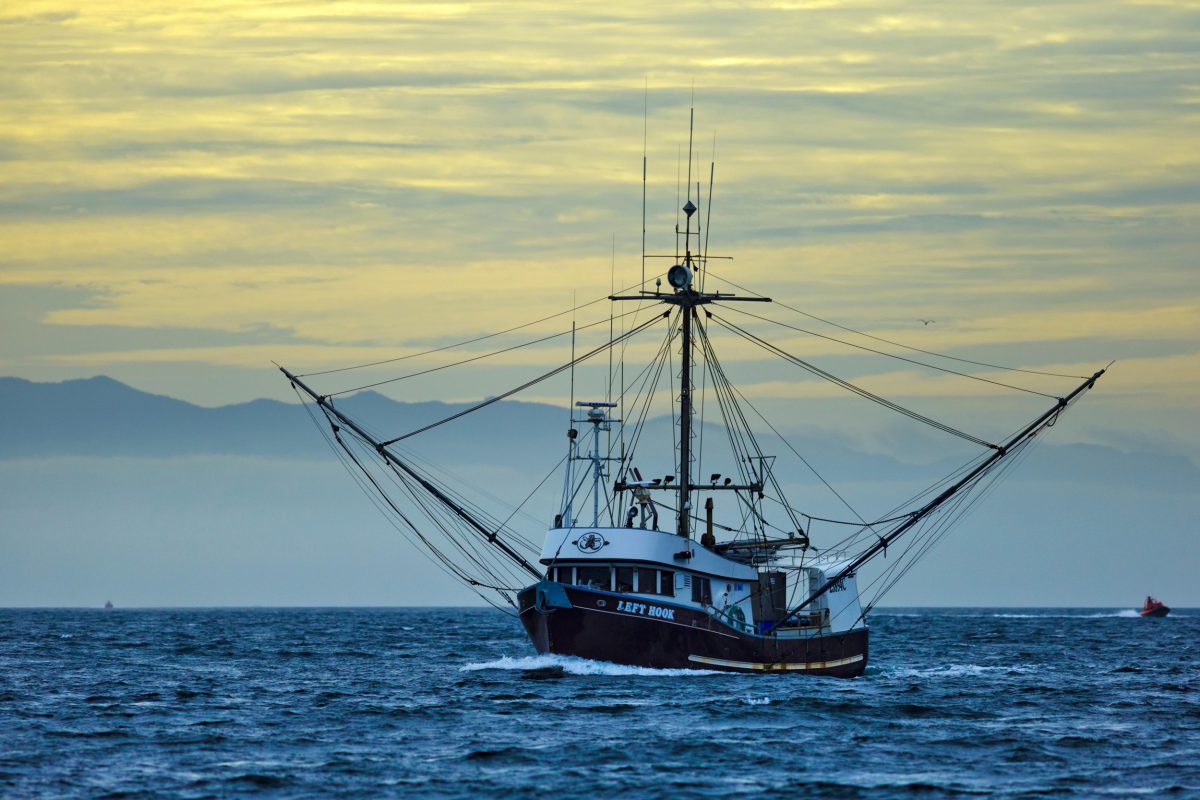
With 80 percent (by volume) of Canadian fisheries certified by the Marine Stewardship Council, researchers from sustainable seafood watchdog SeaChoice say there’s little opportunity to affect change on the water unless the standards are raised or actually enforced to the degree that consumers expect. Photo by Don White/Alamy Stock Photo
The MSC, on the other hand, helps drive change on the water when fisheries are striving for certification. In Canada, for example, haddock fisheries started using separator trawl nets that allow cod to escape, reducing by-catch. The SeaChoice report, however, found that once fisheries are MSC certified, they rarely change their practices in ways that reduce the environmental impacts on habitat, non-target species, and ecosystems function. The MSC disputes this claim, saying from 2006 to 2016, MSC-certified fisheries in Canada made 167 such improvements.
Over the months of investigating the real meaning behind ecolabels, I’ve lost faith in them. I appreciate how all those eye-catching fish stamps have created a huge amount of awareness about sustainable seafood, which we need now more than ever as climate change, pollution, and overfishing threaten our oceans and our bouillabaisse. Ecolabels have helped engage consumers in sustainable seafood by giving us the opportunity to vote with our wallets. The irony is that in doing so, they have branded and commodified sustainability, creating competition in the ecolabel market and driving down standards as programs seek to capture more market share. Ecolabels were supposed to make it easier to eat sustainably, but now consumers have to sort through a cornucopia of claims and figure out whether or not the information is accurate.
Retailers are starting to eschew ecolabels and instead communicate their commitment to sustainability directly to consumers. SeaChoice recently looked at how supermarket chains across the country label their seafood and found that the retailer with the best labeling and sustainability policies—Metro, which has more than 940 stores in Quebec and Ontario—doesn’t even have an ecolabel partner. “It makes you realize it’s just a matter of a corporate philosophy ultimately,” says Wallace. “You don’t really need an NGO partner, you don’t need labels; you can just decide to make a commitment to sustainable seafood.”
For consumers, it’s a little harder to make that commitment without some guidance, but it’s not impossible. I’ve found a few ways to have my seafood and eat it too. I’ve gone fishing with friends when the pink salmon are running, forcing myself to bop the fish on the head and help gut them. I’ve gone paddleboarding with a crab trap in tow and dined on the resulting bounty on the beach. I’ve started frequenting a local fishmonger that operates its own fleet of vessels and ensures staff can tell shoppers where their seafood was caught, the name of the boat it came in on, and the best wine to pair it with. And when I’m uncertain about the authenticity or sustainability of seafood, I go vegetarian. It’s the only way to avoid moral indigestion.

